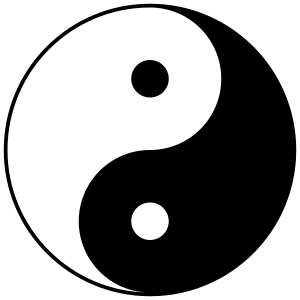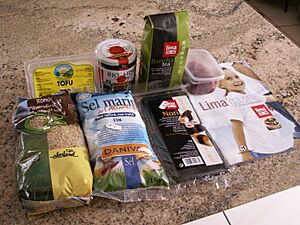Macrobiotic diet facts for kids
| Alternative medicine | |
|---|---|
| Claims | Health effects from a diet avoiding refined foods and most animal products. Specific effects on cancer. |
| Related fields | Diet |
| Original proponents | Sagen Ishizuka |
| Subsequent proponents | George Ohsawa Michio Kushi William Dufty Edward Esko |
A macrobiotic diet is a way of eating based on ideas from Zen Buddhism. It tries to balance different types of food and even cooking tools. The main ideas are to eat fewer animal products, choose foods grown nearby and in season, and eat meals in small amounts.
There is no strong scientific proof that a macrobiotic diet helps people with cancer or other sicknesses. In fact, it might even be unhealthy if not done carefully. Big health groups like the American Cancer Society do not suggest this diet for treating diseases.
Contents
What is the Macrobiotic Diet About?

The macrobiotic diet is linked to Zen Buddhism. It uses the idea of balancing yin and yang. These are two opposite forces that are believed to be in everything, including food. The diet suggests eating foods to get a good balance of these forces.
A man named George Ohsawa made this diet popular in the 1930s. Later, his student Michio Kushi shared more ideas about it. This way of eating is different from what most doctors and scientists recommend for health.
Macrobiotics focuses on eating whole grains, like brown rice, and other plant foods. These include beans, vegetables, edible seaweed, and fermented soy products. These foods are put together in meals to create a balance of yin and yang.
Foods with yang qualities are thought to be heavy and warm. Foods with yin qualities are seen as light and cool. But these ideas are always compared to other foods. For example, brown rice is considered very balanced.
Some vegetables, like tomatoes, peppers, potatoes, and eggplant, are not often eaten in macrobiotic cooking. This is because they are seen as very yin. Some people who follow the diet believe these vegetables can cause problems like inflammation.
How the Diet Works
Food Choices
Here are some general rules for a macrobiotic diet, though it can change depending on where you live and your needs:
- Whole grains, especially brown rice, eaten slowly: 40–60% of your meal.
- Vegetables: 25–30%
- Beans and other legumes: 5–10%
- Miso soup: 5%
- Sea vegetables (like seaweed): 5%
- Naturally prepared foods: 5–10%
Foods like fish, seeds, nuts, and some fruits can be eaten sometimes, maybe two or three times a week.
Kitchen Tools
The diet also suggests using certain cooking tools. It says that tools should be made from wood or glass. It recommends avoiding plastic, copper, and non-stick pans. Electric ovens are also usually not used.
Japanese Roots
The macrobiotic diet became well-known in Japan. Long ago, during the Edo period in Japan, many people ate mostly rice and soybeans. Some people who follow the macrobiotic diet believe that in the past, most people around the world ate mainly grains, vegetables, and other plants. Because the diet started in Japan, many Japanese foods that are thought to be healthy are part of modern macrobiotic eating.
What About Cancer?
The American Cancer Society suggests eating a diet that is low in fat and high in fiber, mostly from plants. However, they warn people with cancer not to rely only on a special diet as their main treatment. Cancer Research UK also says that there is no scientific proof that a macrobiotic lifestyle can help fight cancer or cure it.
Experts like nutritionist Fredrick J. Stare have said there is no scientific evidence that macrobiotic diets help with cancer or any other disease.
Nutrition and Safety
Getting Enough Nutrients
The macrobiotic diet is a type of fad diet, which means it's a popular diet that might not be based on strong science.
It can be hard to get all the nutrients you need on this diet. Fish can provide vitamin B12. While some plant foods are fortified (have B12 added to them), natural plant foods do not contain it. You can get Vitamin A from plants like carrots and spinach. You can also get enough protein from grains, nuts, seeds, and beans. Foods like soy products, walnuts, and flax seeds provide healthy fats called Omega-3s. Most other B vitamins are found in whole grains. Iron can be found in beans, sea vegetables, and leafy greens.
Safety Concerns
People who offer macrobiotic advice are not officially regulated in some places, like the United Kingdom. This means they don't always need special training.
Some very strict versions of the macrobiotic diet, which only allowed brown rice and water, have led to serious health problems and even death in the past. If a macrobiotic diet does not include any animal products, it can cause a lack of important nutrients unless it is planned very carefully. This can be especially risky for people with cancer, who often need more nutrients and might lose weight easily. Relying only on this diet for cancer treatment and avoiding regular medical care can have serious health consequences.
For Children
Children need many nutrients to grow. A macrobiotic diet might not have all the nutrients that growing children need. This means children could be at risk of not getting enough vitamins and minerals.
During Pregnancy
Macrobiotic diets have not been studied much in pregnant or breastfeeding women. The strictest versions of the diet might not provide enough nutrients for a baby to grow normally.
See also
- Ch'i
- Chinese food therapy
- List of diets
- List of unproven and disproven cancer treatments
- Sanpaku
- Shiatsu
- Traditional Chinese medicine


